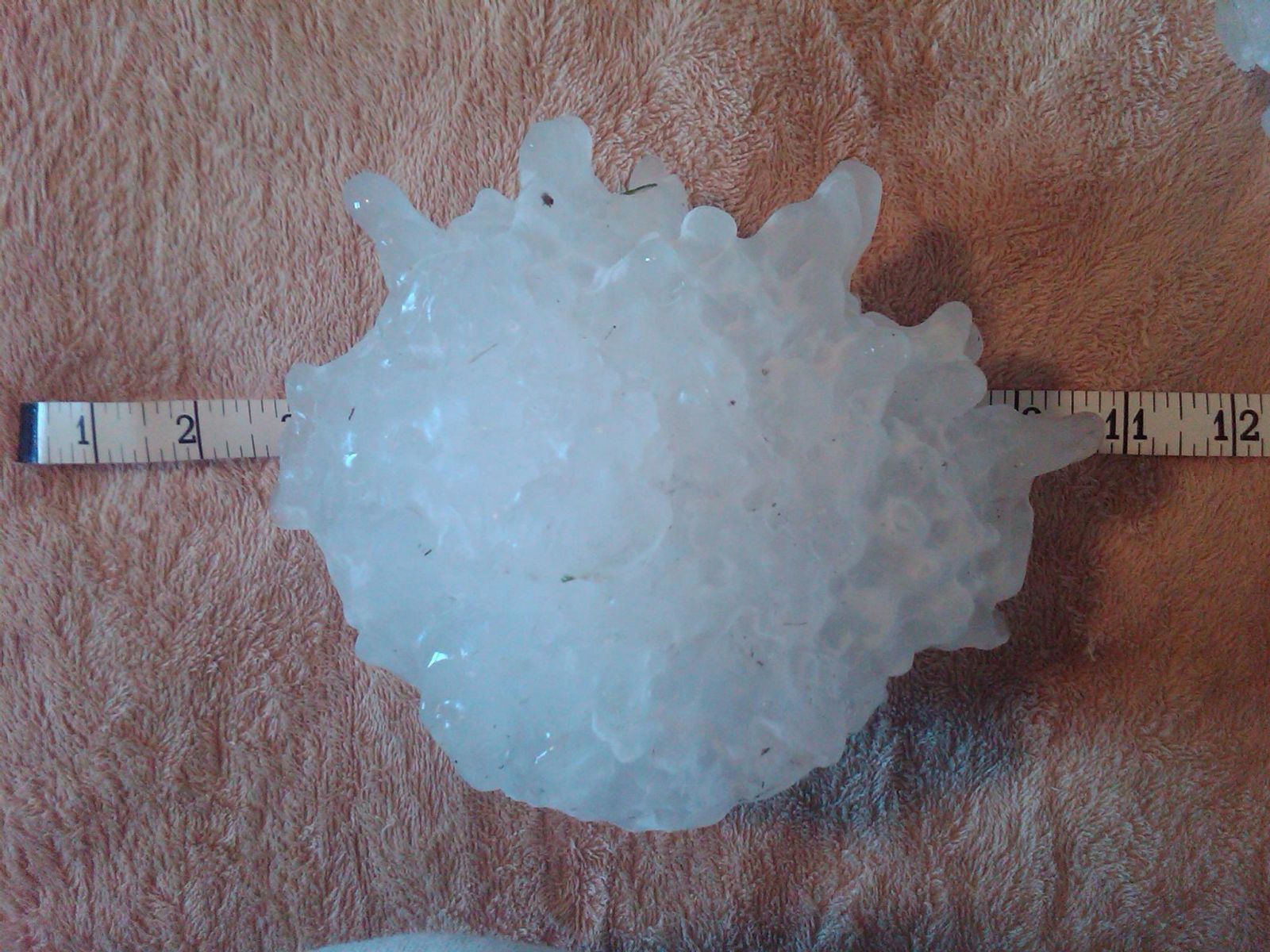Science Snapshots: Small Seedless Watermelon Size Hail in Colorado
The weather has been weird, guys. Including in eastern Colorado, where a huge ass hailstone fell. If verified, it will be Colorado's largest!
Dan Fitts is a storm chaser and your Captain endorses him as a good one. He's a farmer in Nebraska, and farmers are basically the only people I give a total pass to in terms of teaching me the weather with no formal training. My grandpa woke up one time during a tornado warning, went outside to look, decided it was no big deal and went back to sleep. And he was right, because the tornado didn't drop until it was 5 minutes up the road. Farmers KNOW the weather.
Anyway, Mr. Fitts found this:
Fell on Highway 36 about 8 miles ENE of Kirk, Colorado just as tornado was developing @nwsgoodland #cowx pic.twitter.com/7qsvGpSKiR
— Dan Fitts (@Dan_Fitts) August 9, 2023
There are three great things about this post that exemplify why Dan Fitts is a great chaser. First, he gave a location and approximate time. Second, he tagged the National Weather Service Office in Goodland, KS, who need this information to do their jobs and either issue, upgrade, or verify their warnings (and they can tweet him back for more info and he'll respond). Third, he's given a proper measurement with the ruler, which will help verify this event.
And why do we care about this hailstone? Because at 5.25 in (13.36 cm), once the Colorado state climatologist office verifies this hailstone observation (and I'm 98% sure they will), it will be Colorado's first over 5 in (12.7 cm) and ergo the largest in recorded state history. The previous record was measured at 4.83 in (12.27 cm) and fell near Bethune, CO (about 30 miles south of Kirk where the current one was found) in August 2019. Fun fact: the Colorado state climatologist did pretty well on Jeopardy several years ago.
This same storm near Kirk, CO also dropped a tornado that may be an EF-4 given preliminary damage reports, which would be the first EF-4 in Colorado since the Fujita scale was changed to the Enhanced Fujita scale in 2007. Dan Fitts saw that too.
Yuma, Colorado #tornado turned green as it chewed up a corn field just WSW of town @NWSGoodland @NWSBoulder @SevereStudios @KNEBStormCenter @dayweather #cowx pic.twitter.com/Q1WB8L61S9
— Dan Fitts (@Dan_Fitts) August 9, 2023
This is nowhere near THE largest hailstone though, just the largest in Colorado. The largest fell in Vivian, South Dakota on 23 July 2010. It broke the record for largest hailstone at 8.0 in (20.32 cm) in diameter and also broke the record for weight at 1.9375 lbs (0.88 kg). These records were previously held by the Aurora, Nebraska (7.0 inches, 17.78 cm, 22 June 2003) and Coffeyville, Kansas (1.67 lbs, 0.76 kg, 3 September 1970) hailstones respectively. The Aurora hailstone retains the record for largest circumference at 18.75 in (47.63 cm), 0.125 in larger than Vivian.
 |
| The Vivian hailstone, NOAA/NWS |
It's possible there have been larger hailstones out there, even in recent times given that reports are biased depending on population and where people live and work. But these are the ones we have, and it's always exciting as a meteorologist when a meteorological record is broken. Although, my car has been hit by baseball size hail and that was bad enough, so I'm glad I wasn't there.
The technical largest size of hail report using an object is grapefruit at 4.5 in (11.43 cm), but these record-breakers belong in my favorite unofficial category: small seedless watermelon. Though the Vivian stone is fairly close to the size of my second favorite unofficial category: basketball size.
This area of the world where this giant hail falls is very unique weather-wise, and is the same reason it has been christened tornado alley. Unlike tornadoes though, the United State's hail has a strong competitor in Argentina, which is one of the world's hotspots for both lightning and hail. In fact, a hailstone that fell in Villa Carlos Paz may actually be the record holder, estimated at between 7.4 and 9.3 in (18.8 and 23.62 cm), but this estimate was from a photo and therefore can't be "officially" verified since a ruler wasn't involved. This is reported by Matthew Kumjian of Penn State, one of the world's premier hail researchers. This area's uniquely strong storms were studied during the Remote sensing of Electrification, Lightning, And Mesoscale/microscale Processes with Adaptive Ground Observations (RELAMPAGO) field campaign in 2018-2019. Yes, we truly do decide the acronym we want, then make relevant words fit the acronym. I wasn't able to be involved in this one, sadly, but a lot of my friends went and it was highly successful. You can see a few other hotspots for hail across the world in the map below:
 |
| Annual hail probability in days per year, Allen et al. 2020, EOS) |
Hail forms when a frozen particle is repeatedly carried aloft by a strong updraft, or the air the storm is sucking in before it dumps out rain in the downdraft. As the particle is lofted, it is coated with water, which freezes when it gets high enough. The stronger the storm, the stronger/faster its updraft, and the faster the updraft, the heavier hailstone it can loft for repeated growth. The hailstone eventually falls when its either thrown out of the storm or is too heavy for the storm to keep aloft.
Read a news article about the new Colorado stone here: https://www.9news.com/article/weather/weather-colorado/colorado-big-hailstone-might-set-record/73-e95f2300-eca3-4312-8eee-3f9b2b219026
Read more about the Vivian storm here: https://www.weather.gov/abr/vivianhailstone
Learn more about hail formation here: https://www.nssl.noaa.gov/education/svrwx101/hail/




Comments
Post a Comment